Implementation of a Sensor Solution for Substation Digitalization
- Koji Shinozaki
- Ryohei Numajiri
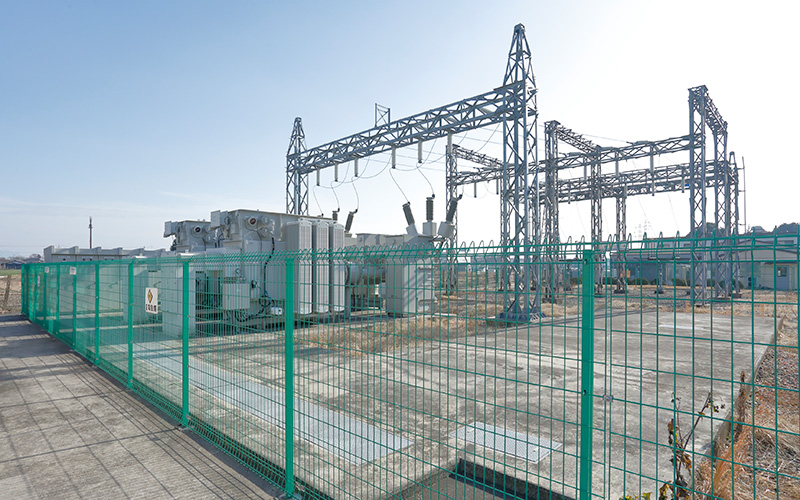
Global energy prices remain at high levels. The presumed cause is the imbalance between energy supply and demand due to recovery in economic activity from the spread of COVID-19, unseasonable weather, disasters, Russia's invasion of Ukraine, and other factors. The soaring energy prices naturally have an impact on the electricity sector, putting not only ordinary households but also electricity suppliers, or electric power companies, in a difficult situation. Power companies are being forced to cut costs to keep power prices down.
Particularly in the field of power transmission and transformation, one of the issues is aging equipment installed during a period of power grid expansion in the late 1980s. Each substation is required to maintain and update such equipment and achieve more efficient operation. The business environment surrounding power companies is becoming increasingly severe.
Under these circumstances, what is attracting attention is digitalization, which introduces rapidly developing technologies such as big data, IoT, and artificial intelligence (AI). The benefits of a digitalized substation include cost reduction through reduced wiring of control cables and other means of equipment simplification, efficiency and labor savings through remote control, and sensing technology-based identification of signs of, and prevention of, equipment failures.
To meet the needs for substation digitalization, Takaoka Toko developed a sensor solution that assists equipment maintenance and management and verified the solution using actual equipment.
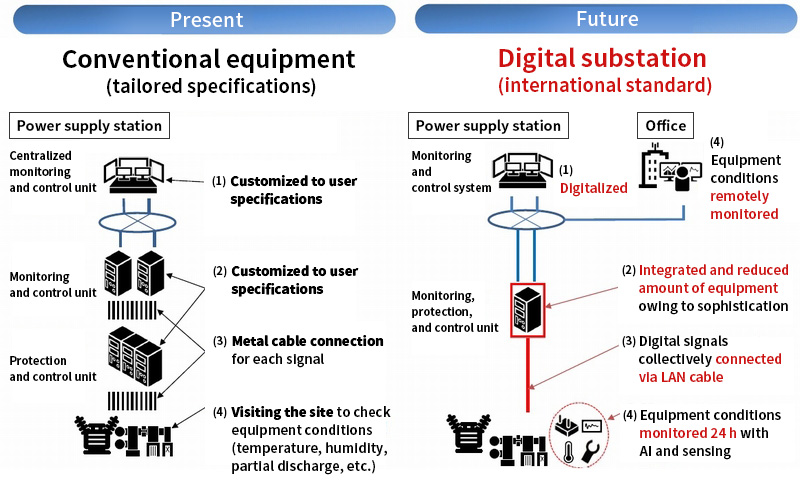
Technology
Sensor Solution That Is Easy to Build and Introduce
In the field of power transmission and transformation, there is a growing trend toward the use of data for efficiency to maintain aging equipment and operate it efficiently. Against this background, Takaoka Toko has developed a sensor solution to digitalize maintenance and management of substation equipment. The sensor solution has been delivered to the Misakimachi Substation (Misaki-cho, Isumi City, Chiba Prefecture) of TEPCO Power Grid, Inc. (hereinafter referred to as TEPCO PG) and subjected to demonstration and verification.
The sensor solution consists of various sensors that measure equipment conditions and convert measurements into data, sensor interface units (SIUs) that compile information from various sensors, edge devices that receive and aggregate sensing information and transmit it to a data server, a data server that accumulates data, and a maintenance data analysis system. Sensing information collected via SIUs and edge devices to the data server can be viewed at any location using the maintenance data analysis system, allowing signs of equipment deterioration to be monitored remotely, helping to prevent equipment failures.
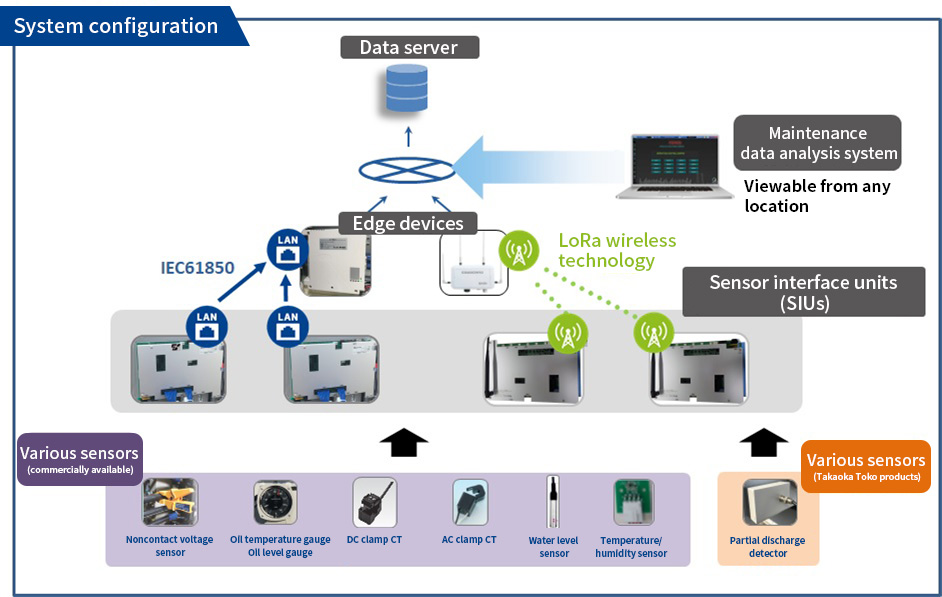
Because most of the sensors used are commercially available, it is possible to configure the system at a low cost even when sensing involves many pieces of equipment. Being easily available, the sensors can be replaced with ease in the event of a failure.
Two types of communication are available between the SIUs and edge device: wired communication and wireless communication. To ensure universality, wired communication uses an international standard protocol based on the IEC 61850 standard. Additionally, it enables high-speed, large-capacity data communication since it is wired communication. For wireless communication, LoRa technology is used, which features long-distance communication. Needless to say, it requires no cable installation and can transmit data even if the SIUs and edge device are far apart. If communication between the SIUs and edge device is unstable, installing a repeater will enable longer distance communication, allowing sensing regardless of the location of the equipment to be sensed. In addition, when installing a repeater, it is possible to connect up to 2-stage relay.
The maintenance data analysis system has a built-in database; therefore, as another feature, the solution can be constructed even without a data server. In the present demonstration and verification, we used an existing server owned by TEPCO PG.
In the future, we will evaluate the information obtained from the verification, study how to make use of that information, and investigate its effectiveness. Based on this experience, we will explore expanded application of the solution to domestic power companies and general industries.
Profile
-
 Koji ShinozakiPower Equipment & System Business Division
Koji ShinozakiPower Equipment & System Business Division
Power Equipment System Manufacturing Department
Protection & Control Equipment Design Group -
 Ryohei NumajiriPower Equipment & System Business Division
Ryohei NumajiriPower Equipment & System Business Division
Power Equipment System Manufacturing Department
Protection & Control Equipment Design Group
Addressing the challenges and needs in the field of power transmission and transformation
ShinozakiMaintenance and management of power transmission and substation equipment are critical for a stable supply of electricity. Currently, power company workers patrol each substation and perform maintenance work. Recent issues associated with this are an aging workforce and a shortage of human resources. Making the work more efficient and saving labor have been recognized as needs. The present solution is designed to meet those needs. By implementing our solution, it becomes possible to remotely monitor substations in real time without the need for workers to patrol substations located here and there, allowing for efficient checks on their condition with fewer personnel.
NumajiriOf course, it also reduces the risk of power outages due to equipment failure. If equipment failures can be predicted, countermeasures can be taken before failures occur and power outages can be minimized. Power outages affect not only power companies but also power consumers. In this respect as well, the sensor solution is expected to be beneficial.
ShinozakiIn recent years, in the electric power sector, digitalization that utilizes new digital technologies such as big data, IoT, and AI has also been attracting great interest. What is done in digitalization at substations is wide-ranging. Our solution utilizes IoT to save labor in checking and maintaining equipment conditions.

A solution refined through repeated on-site surveys and reviews
ShinozakiIn this solution development, I was in charge of developing the SIU and selecting the sensors. What I was particularly determined to do was to select commercially available sensors for the most part. Developing a purpose-designed product tends to be expensive. In contrast, procuring commercially available items enables cost reduction. Moreover, an advantage of doing so is that being readily available, they are easy to replace. I also made sure that the sensors would be maintenance-free by choosing a type that would not fail over a long period of time. The sensors mounted are intended to eliminate the need for patrols. Visiting the site to maintain sensors would be putting the cart before the horse. In developing the SIU, two types of communication methods, wireless and wired, were adopted to choose from according to the location, the surrounding environment, and needs of each substation. The wireless method uses LoRa wireless technology, which enables long-distance communication. This choice is intended for easier implementation of the solution in cases where a large site raises concerns about wireless coverage. Furthermore, the wired method complies with an international standard for increased versatility.
NumajiriI took care of studying higher-level components, such as the communication protocol and the maintenance data analysis system, which are above the sensors and SIUs. In the present project, the customer desired to use an existing data server, so we determined the specifications for data transmission based on the customer's requests and developed a new system interface. The present solution can tune the system configuration accommodating customer requests. Conversely, we can provide an entire set, including the data server, and are willing to make flexible proposals tailored to some specific facility environment.
ShinozakiEach customer may have a different need for a data server, so when we receive a request, we will have consultations on specifications in advance. After we made the proposal, we had meetings with TEPCO PG once a month or so. In addition, we visited the site many times to conduct repeated investigations and discussions. As we determined what kind of configuration to develop and what kind of sensors to use in cooperation with the customer, we had difficulties in reaching agreement on the sensing items required by the customer. The implementation of the solution was required to coincide with substation shutdown. Accordingly, date and time restrictions were imposed on on-site work. In the present project, the delivery was made in February, during the winter, so if the equipment were down for a long time, it would have an impact on winter electricity demand. To work in the allowed time and deliver the solution by the scheduled date, the entire team worked together to complete everything, from procuring materials to installing a maintenance data analysis system outside the substation.
NumajiriWhen developing the maintenance data analysis system, it was difficult to establish specifications tailored to the customer. Working out the solution was probably also difficult due to the need to adjust the specifications to another verification conducted by the customer. It was a tough task to make successful arrangements, but it was worth the effort. We developed the maintenance data analysis system together with an overseas partner company. In that process, establishing communication was indeed difficult. We proceeded by organizing and checking the information as appropriate to ensure that our intentions and requests were clearly understood even through an interpreter.
ShinozakiWhen it comes to difficulties, I remember that the customer had a plan to install another product in the same equipment after the delivery of our solution. Arrangements were made through consultation with the customer on the locations of our system and the system to be installed later so as not to affect each other. When the actual equipment is not available anywhere but at the site, work done in the company is naturally limited to a desk study. I remember that there was a lot of trial and error during the on-site investigation and installation work.

For expanded application to general industries as well as to electric power companies
ShinozakiWe have accumulated data since the delivery of the solution to the site. Currently, we are in the phase where we should analyze the data and, based on the analysis results, discuss with the customer the next step to take. Rather than just delivering a product, we will evaluate the sensing information obtained and propose ways to utilize that information. Data collected during demonstration and verification may contain unexpected information in the form of numerical values. I would like to analyze each of those numerical values to know the equipment conditions corresponding to those numbers, accumulate the findings, and use them as a clue to detect equipment abnormalities and failures in the future. Based on the current experience, I would like to expand the solution to other power companies in the future. Also, in the general industry sector, large factories have electric power equipment installed, so I would like to make proposals to such customers, as well as to electric power companies.
NumajiriThis project was the first time I was involved in working out specifications for communications. I'm glad that we were able to decide on them properly and that we were able to successfully complete delivery, demonstration, and verification. Also, this was my first time interacting with an overseas partner company. I would like to use this experience for future development work or other projects.
ShinozakiThis project, or a proposal-based project, was also my first experience. We provided a proposal to the customer, which was accepted, completed the solution to its final form, and conducted its demonstration and verification. These make me feel that I have achieved substantial results. In creating something from scratch, I think the real thrill and fun of being an engineer is being able to think and create it yourself, so I will continue to work on development while proactively absorbing new information and technology.

Latest articles
-
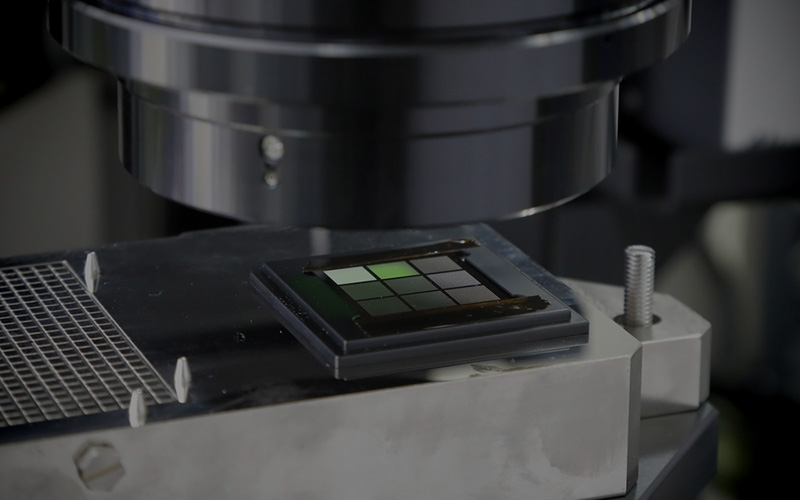 interviewThe confocal surface shape measurement system for semiconductor reliabilityIt is no exaggeration to say that semiconductors are used in everything supporting our lives and industry in modern society. Examples include smartphones, home appliances, and industrial products in various fields.
interviewThe confocal surface shape measurement system for semiconductor reliabilityIt is no exaggeration to say that semiconductors are used in everything supporting our lives and industry in modern society. Examples include smartphones, home appliances, and industrial products in various fields. -
 interviewImplementation of a Sensor Solution for Substation DigitalizationGlobal energy prices remain at high levels. The presumed cause is the imbalance between energy supply and demand due to recovery in economic activity from the spread of COVID-19, unseasonable weather, disasters, Russia's invasion of Ukraine, and other factors. The soaring energy prices naturally have an impact on the electricity sector, putting not only ordinary households but also electricity suppliers, or electric power companies, in a difficult situation. Power companies are being forced to cut costs to keep power prices down.
interviewImplementation of a Sensor Solution for Substation DigitalizationGlobal energy prices remain at high levels. The presumed cause is the imbalance between energy supply and demand due to recovery in economic activity from the spread of COVID-19, unseasonable weather, disasters, Russia's invasion of Ukraine, and other factors. The soaring energy prices naturally have an impact on the electricity sector, putting not only ordinary households but also electricity suppliers, or electric power companies, in a difficult situation. Power companies are being forced to cut costs to keep power prices down. -
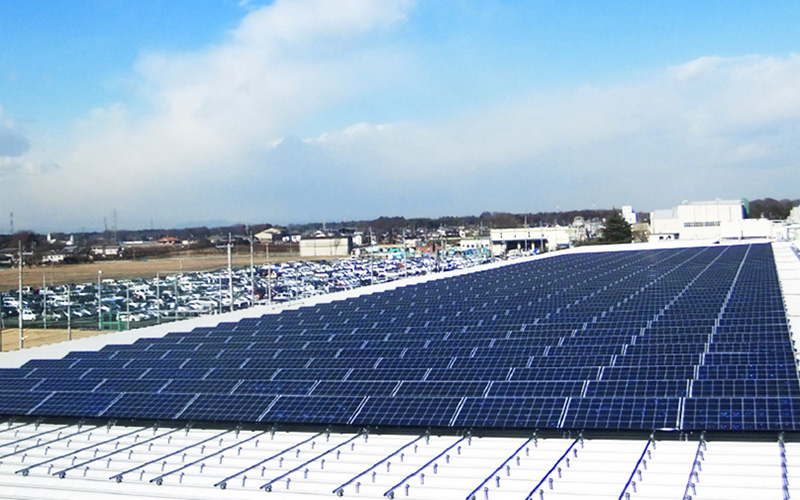 interviewDevelopment of Techniques for Solar Power Generation Prediction Using AIIn order to promote carbon neutrality, the use of renewable energy that doesn't emit CO2 is expanding.Among renewable energy resources, solar power generation is an important one which will continue to grow in popularity.
interviewDevelopment of Techniques for Solar Power Generation Prediction Using AIIn order to promote carbon neutrality, the use of renewable energy that doesn't emit CO2 is expanding.Among renewable energy resources, solar power generation is an important one which will continue to grow in popularity. -
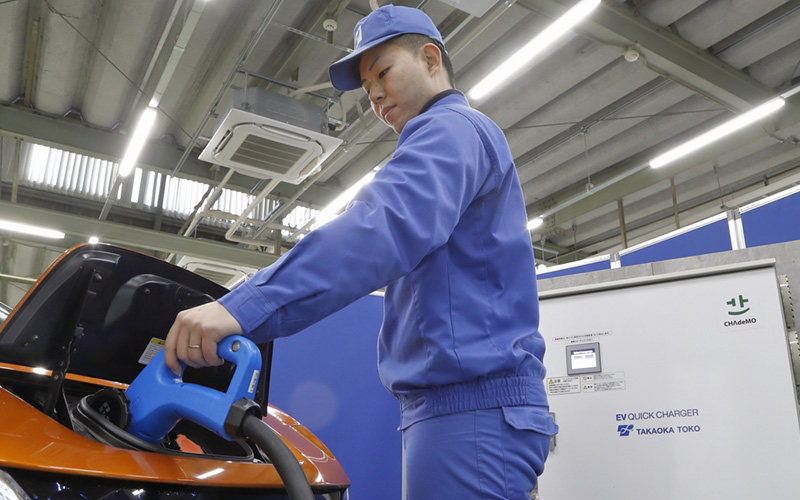 interviewDevelopment of Medium-Capacity Quick Charger for Electric VehiclesIn anticipation of expansion of EV charging infrastructure in Japan, where the EV shift is accelerating, we worked on the development of the “medium-capacity quick charger (B11)” as a charger that meets the needs for intermediate chargers between normal chargers and quick chargers. This article introduces the features of the product, ingenuity in the development process, and our future vision.
interviewDevelopment of Medium-Capacity Quick Charger for Electric VehiclesIn anticipation of expansion of EV charging infrastructure in Japan, where the EV shift is accelerating, we worked on the development of the “medium-capacity quick charger (B11)” as a charger that meets the needs for intermediate chargers between normal chargers and quick chargers. This article introduces the features of the product, ingenuity in the development process, and our future vision.
